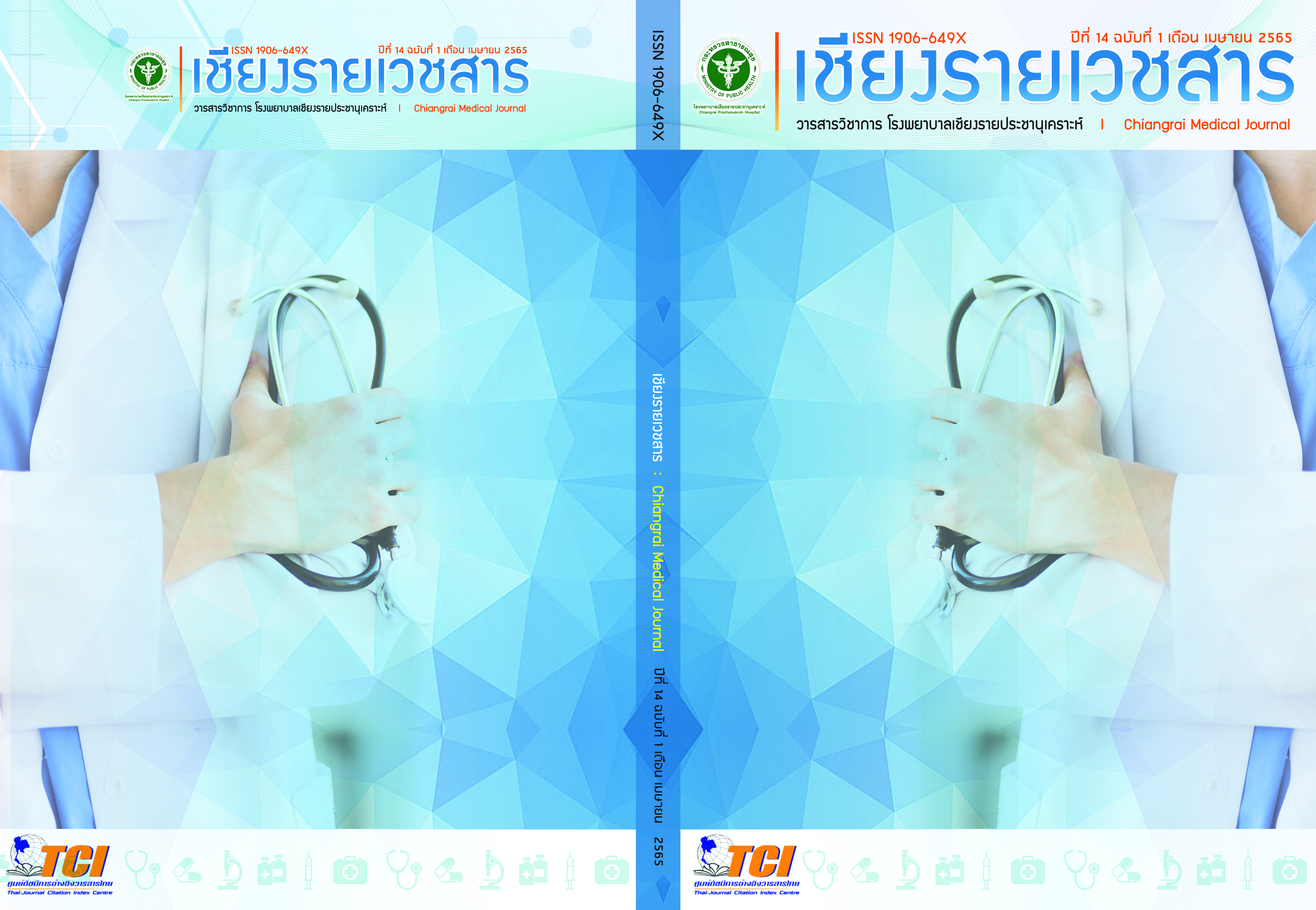การใช้ยารักษาตนเองและปัจจัยที่เกี่ยวข้อง ในกรุงพนมเปญ ประเทศกัมพูชา
Main Article Content
บทคัดย่อ
ความเป็นมา : การใช้ยารักษาตนเอง เป็นการใช้ยาโดยไม่มีใบสั่งแพทย์ซึ่งมีประโยชน์ต่อทั้งประชาชนและบุคลากรทางการแพทย์ อย่างไรก็ตามการใช้ยารักษาตัวเองอย่างไม่เหมาะสมทำให้เกิดความเสี่ยงได้ บุคลากรทางการแพทย์มีหน้าที่รับผิดชอบในการดูแลให้เกิดการใช้ยาอย่างปลอดภัยในประชาชน
วัตถุประสงค์ : เพื่อศึกษาพฤติกรรมการใช้ยารักษาตนเอง ความรู้ในการใช้ยา ความรอบรู้ด้านการใช้ยา และปัจจัยที่มีผลต่อพฤติกรรมการใช้ยารักษาตนเองของประชาชน ในกรุงพนมเปญ ประเทศกัมพูชา
วิธีการศึกษา : การศึกษาแบบภาคตัดขวางดำเนินการในกรุงพนมเปญระหว่างมกราคม ถึง กุมภาพันธ์ พ.ศ. 2564 เก็บข้อมูลด้วยวิธีการสัมภาษณ์แบบเผชิญหน้า โดยใช้แบบสอบถามแบบมีโครงสร้าง จากผู้ตอบแบบสอบถามจำนวน 383 ราย วิเคราะห์ข้อมูลด้วยสถิติเชิงพรรณนา และสถิติเชิงอนุมาน
ผลการศึกษา : ผู้ตอบแบบสอบถาม ร้อยละ 67.60 มีพฤติกรรมการใช้ยารักษาตนเอง ในช่วง 12 เดือนที่ผ่านมา
ใช้ยาลดไข้ (ร้อยละ 25.20) และ ยาแก้ปวดศีรษะ (ร้อยละ 21.60) แหล่งข้อมูลหลัก คือ เภสัชกร (ร้อยละ 28.80) และเหตุผลของการใช้ยารักษาตนเองเนื่องจากเป็นโรคที่ไม่ซับซ้อน (ร้อยละ 40.90) ผู้ตอบแบบสอบถาม ร้อยละ 57.20 และ 55.60 มีความรู้เกี่ยวกับการใช้ยาอยู่ในระดับน้อย และ ความรอบรู้ด้านการใช้ยาในระดับต่ำ ปัจจัยที่มีผลต่อพฤติกรรมการใช้ยารักษาตนเอง คือ รายได้ต่อเดือน (adjOR : 3.69; 95%CI: 1.11-12.25) การมีโรคเรื้อรัง (adjOR : 0.42; 95%CI: 0.18-0.97), และความรอบรู้ด้านการใช้ยา (adjOR : 0.41; 95%CI: 0.19-0.89)
สรุปและข้อเสนอแนะ : ผลการศึกษาครั้งนี้แสดงให้เห็นว่า โดยทั่วไป ประชาชนใช้ยารักษาตนเองสำหรับโรคที่เป็นความเจ็บป่วยเล็กน้อยและเข้าถึงยาได้ง่าย ปัจจัยรายได้ โรคประจำตัว และความรอบรู้ด้านการใช้ยามีผลต่อพฤติกรรมการใช้ยารักษาตนเองอย่างมีนัยสำคัญ บุคลากรทางการแพทย์โดยเฉพาะเภสัชกรชุมชนควรเพิ่มการให้ความรู้เกี่ยวกับการใช้ยารักษาตนเองที่เหมาะสมแก่ประชาชน
Article Details

อนุญาตภายใต้เงื่อนไข Creative Commons Attribution-NonCommercial-NoDerivatives 4.0 International License.
เอกสารอ้างอิง
Who Consultative Group on the Role of the Pharmacist in the Health Care System Omdls. The role of the pharmacist in self-care and self-medication : report of the 4th WHO Consultative Group on the Role of the Pharmacist : The Hague, The Netherlands, 26-28 August 1998. Geneva: Dept. of Essential Drugs and Other Medicines, World Health Organization; 1998.
You JH, Wong FY, Chan FW, Wong EL, Yeoh EK. Public perception on the role of community pharmacists in self-medication and self-care in Hong Kong. BMC Clin Pharmacol. 2011;11:19.
Westerlund T, Barzi S, Bernsten C. Consumer views on safety of over-the-counter drugs, preferred retailers and information sources in Sweden: after re-regulation of the pharmacy market. Pharm Pract (Granada). 2017;15(1):894.
Understanding Over-the-CounterMedicines[Internet].U.S.Food&Drug dministration; 2018[updatedMay16;cited2020June14].Availablefrom: httpps://www.fda.gov/drugs/buying-using-medicine-safely/understanding-over-counter-medicines.
Hughes CM, McElnay JC, Fleming GF. Benefits and risks of self medication. Drug Saf. 2001;24(14):1027-37.
Bureau-Point E, Baxerres C, Chheang S. Self-medication and the pharmaceutical system in Cambodia. Med Anthropol. 2020;39(8):765-81.
Prien C. The awareness of antimicrobial use and antimicrobial resistance among out patints: a case study at Batheay referral hospital at kampong Cham Province, Cambodia: Hanyang University; 2018.
Om C, Daily F, Vlieghe E, McLaughlin JC, McLaws ML. Pervasive antibiotic misuse in the Cambodian community: antibiotic-seeking behaviour with unrestricted access. Antimicrob Resist Infect Control. 2017;6:30.
Sridhar SB, Shariff A, Dallah L, Anas D, Ayman M, Rao PG. Assessment of nature, reasons, and consequences of self-medication practice among general population of Ras Al-Khaimah, UAE. Int J Appl Basic Med Res. 2018;8(1):3-8.
Singh NK, Trivedi N, Elnour AA, Patel I. Evaluation of knowledge, attitude and practice about self-medication among rural and urban north Indian population. Age. 2015;18(30):31-40.
Nagaraj M, Chakraborty A, Srinivas BN. A Study on the dispensing pattern of ove the counter drugs in retail pharmacies in Sarjapur Area, East Bangalore. J Clin Diagn Res. 2015;9(6):Fc11-3.
Lee C-H, Chang F-C, Hsu S-D, Chi H-Y, Huang L-J, Yeh M-K. Inappropriate self-medication among adolescents and its association with lower medication literacy and substance use. PLOS ONE. 2017;12(12):e0189199.
Eticha T, Mesfin K. Self-medication practices in Mekelle, Ethiopia. PLoS One. 2014 ;9(5):e97464.
Chanvatik S, Kosiyaporn H, Lekagul A, Kaewkhankhaeng W, Vongmongkol V, Thunyahan A. Knowledge and use of antibiotics in Thailand:a 2017 national household survey. PLoS One. 2019;14(8):e0220990.
Hassali MA, Shafie AA, Al-Qazaz H, Tambyappa J, Palaian S, Hariraj V. Self-medication practices among adult population attending community pharmacies in Malaysia: an exploratory study. Int J Clin Pharm. 2011;33(5):794-9
Ha TV, Nguyen AMT, Nguyen HST. Self-medication practices among Vietnamese residents in highland provinces. J Multidiscip Healthc. 2019;12:493-502
Thuzar M, Aung PL. Prevalence of self-medication and its influence in the labor force in rural Hlaing Tharyar,Yangon, Myanmar. Open Public Health J. 2019(1);12:38–44.
Kumar N, Kanchan T, Unnikrishnan B, Rekha T, Mithra P, Kulkarni V, et al. Perceptions and practices of self-medication among medical students in coastal South India. PLoS One. 2013;8(8):e72247.
Ayalew MB. Self-medication practice in Ethiopia: a systematic review. Patient Prefer Adherence. 2017;11:401-13.
Woźniak-Holecka J, Grajek M, Siwozad K, Mazgaj K, Czech E. Consumer behavior in OTC medicines market. Przegla̧d epidemiologiczny. 2012;66(1):157-60.
Hakonsen H, Sundell KA, Martinsson J, Hedenrud T. Consumer preferences for over-the-counter drug retailers in the reregulated Swedish pharmacy market. Health Policy. 2016;120(3):327-33.
Selvaraj K, Kumar SG, Ramalingam A. Prevalence of self-medication practices and its associated factors in Urban Puducherry, India. Perspect Clin Res. 2014;5(1):32-6.
Nutbeam D. Health literacy as a public health goal: a challenge for contemporary health education and communication strategies into the 21st century. Health Promotion International. 2000;15(3):259-67.
Chinn D, McCarthy C. All Aspects of Health Literacy Scale (AAHLS): developing a tool to measure functional,communicative and critical health literacy in primary healthcare settings. Patient Educ Couns. 2013;90(2):247-53.
Suka M, Odajima T, Kasai M, Igarashi A, Ishikawa H, Kusama M, et al. The 14-item health literacy scale for Japanese adults (HLS-14). Environ Health Prev Med. 2013;18(5):407-15.
Plaza-Zamora J, Legaz I, Osuna E, Pérez-Cárceles MD. Age and education as factors associated with medication literacy:a community pharmacy perspective. BMC Geriatrics. 2020;20(1):501.
Vanhaesebrouck A,Vuillermoz C,Robert S,Parizot I,Chauvin P. Who self-medicates? Results from structural equation modeling in the Greater Paris area, France. PLoS One. 2018;13(12):e0208632
Arrais PS, Fernandes ME, Pizzol TD, Ramos LR, Mengue SS, Luiza VL, et al. Prevalence of self-medication in Brazil and associated factors. Rev Saude Publica. 2016;50(suppl 2):13s.
Kamran A, Sharifirad G, Shafaeei Y, Mohebi S. Associations between self-medication, health literacy, and self-perceived health status: a community-based study. Int J Prev Med. 2015;6:66.


